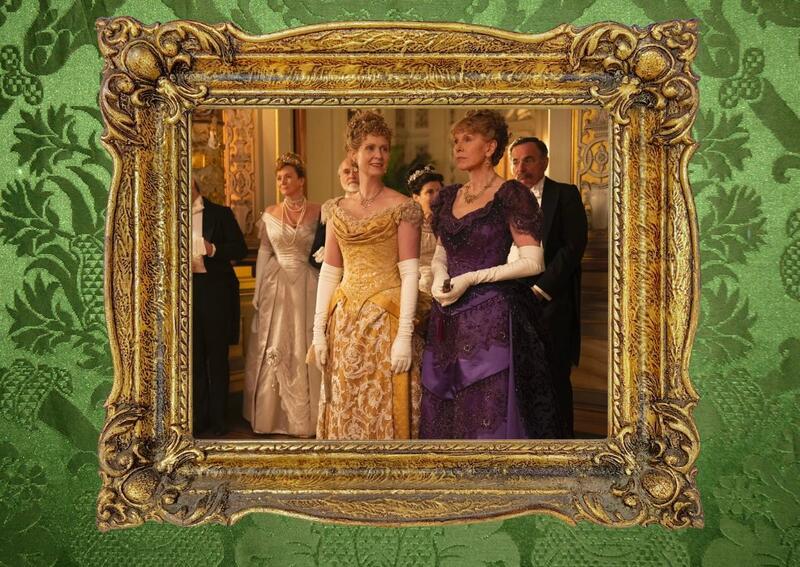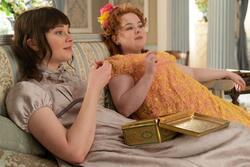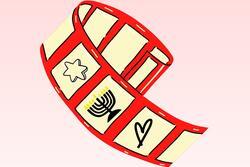Where are the Jews? A Look into "The Gilded Age "
It is a Friday night and I’m exhausted from the week. All day, I anticipate my family’s Shabbat tradition. We will light the candles, say kiddush, and eat my mom’s homemade challah. I can also look forward to one of our rotating Friday night dinner specialties, most likely some sort of pasta dish we fondly call “cheesy mush.” But, most importantly, I can’t wait to watch The Gilded Age.
Throughout the busy week, I await the magical moment when a string orchestra will play the soaring theme song and I can dive into the dazzling world of late-nineteenth century New York. Created by the accomplished Julian Fellowes (who also produced Downton Abbey), The Gilded Age follows the rise and fall of those in New York’s high society. Many characters are either modeled after or are a direct resemblance of notable people from the time, such as the prominent Astor family.
Staying true to Fellowes’ style, the show follows both those “upstairs” and “downstairs.” Viewers get to look in awe at the spectacular evening gowns and glittering jewels of the rich, but also get a sense of the more down-to-earth lives of the servants.
The Gilded Age portrays a more diverse cast of characters than many other all-white historical shows. One notable Black character in the show is Peggy Scott, an aspiring journalist who moves away from home to further her career. She comes from a middle-class family that owns a drug store in Brooklyn—a different perspective on Black life in the post-Civil War era than usually shown in the media. Scott’s character is an important representation of the variety of experiences of Black people at the time, as well as a reminder that women were not confined to one role, either.
However, as I watch The Gilded Age, eager for insight into the (albeit somewhat fictional) world of the New York elite, one absent aspect stands out to me: Where are the Jews?
There is no lack of Jewish perspectives to pick from in New York during the show’s time period; there were many Jews in New York by the late nineteenth century, and their arrival can be categorized in waves. The first, starting during the seventeenth century, was mostly Sephardic Jews. Then, in the nineteenth century (the time of The Gilded Age), most Jewish immigrants had come from Germany. The best-known wave of Jewish immigration to New York was between the end of the nineteenth century and the beginning of the twentieth century, when around 2.5 million people from Eastern European countries arrived in the city. So, really, there was no shortage of stories that Fellowes could have drawn from.
Admittedly, I did initially think that a couple of characters in the show had Jewish ancestry. The portrayal of Mrs. Fish (a real socialite) in The Gilded Age appeared to fall easily into multiple Jewish stereotypes. However, further research into Fish’s family revealed that she was not, as I had once thought, Jewish.
The sometimes-hero, sometimes-anti-hero George Russel (inspired by the robber baron Jay Gould) also seemed like a Jewish contender. But, alas, the actor, Morgan Spector, is Jewish, not the character.
Adding Jewish representation into the series could be an interesting plot point to show an immigrant’s success story into the world of Fifth Avenue New York. Having a narrative of an immigrant who has “made it” would provide an interesting angle to Jewish immigration. Rather than the (perhaps overused) trope of a large family struggling to get by, this different version, like Scott’s character, would provide further insight into the plethora of ways in which Jews lived in New York at that time.
Of course, the story of an immigrant living in a cramped tenement building would also be a welcomed form of representation. Already in The Gilded Age there is an unusual cast of characters working downstairs: an aspiring clock maker, a Kansas-born chef claiming to be French, and an Irish immigrant, just to name a few. What would a Jewish immigrant add, if not opportunities for more interesting discourse, a different worldview added to downstairs life, and, of course, diversity.
Fellowes has already dabbled in including Jewish characters in his shows. In Downton Abbey, Atticus Aldridge, an affluent Jew, is the love interest for a seemingly out of place, sometimes overly spirited American cousin of the Crawleys (the aristocratic protagonist family). However, the plot line of this character’s Judaism was revealed somewhat discreetly through dialogue, and the show seemed eager to ship him back to America with the cousin. This brief encounter with Judaism was enough to give viewers a brief glimpse into the life of wealthy Brits beyond the often stuffy lives of the Crawley family and friends.
Both the Crawleys and the Aldridges seem intent on calling off the nuptials due to differing religious beliefs. This lends an interesting perspective into antisemitism in 1920s England, especially as the show also takes place during the emergence of Nazi presence in Germany. That plotline is also hinted at later in the show, as another protagonist’s husband (notably not Jewish) is assumed to be killed by “Nazi thugs.” While brief, this Jewish character added an interesting angle to the show, and The Gilded Age would benefit from the addition of a similar (if not more complex) Jewish character.
With a renewal for a third season of Gilded Age announced recently, there is much to be potentially included as the story ventures further into the 1880s, and with it the beginning of the massive influx of Eastern European immigrants. I, for one, hope that when I collapse onto the couch to watch Season 3 at the end of a long week, I will be able to see my Shabbat night traditions (excluding, of course, watching TV) modeled on-screen.
This piece was written as part of JWA’s Rising Voices Fellowship.








I've recently become aware that my gr8grandmother came from Germany. Her maiden name was Heinz. Isn't that a Jewish name?None of the family identify as Jewish. She married my gr8grandfather from Sweden.